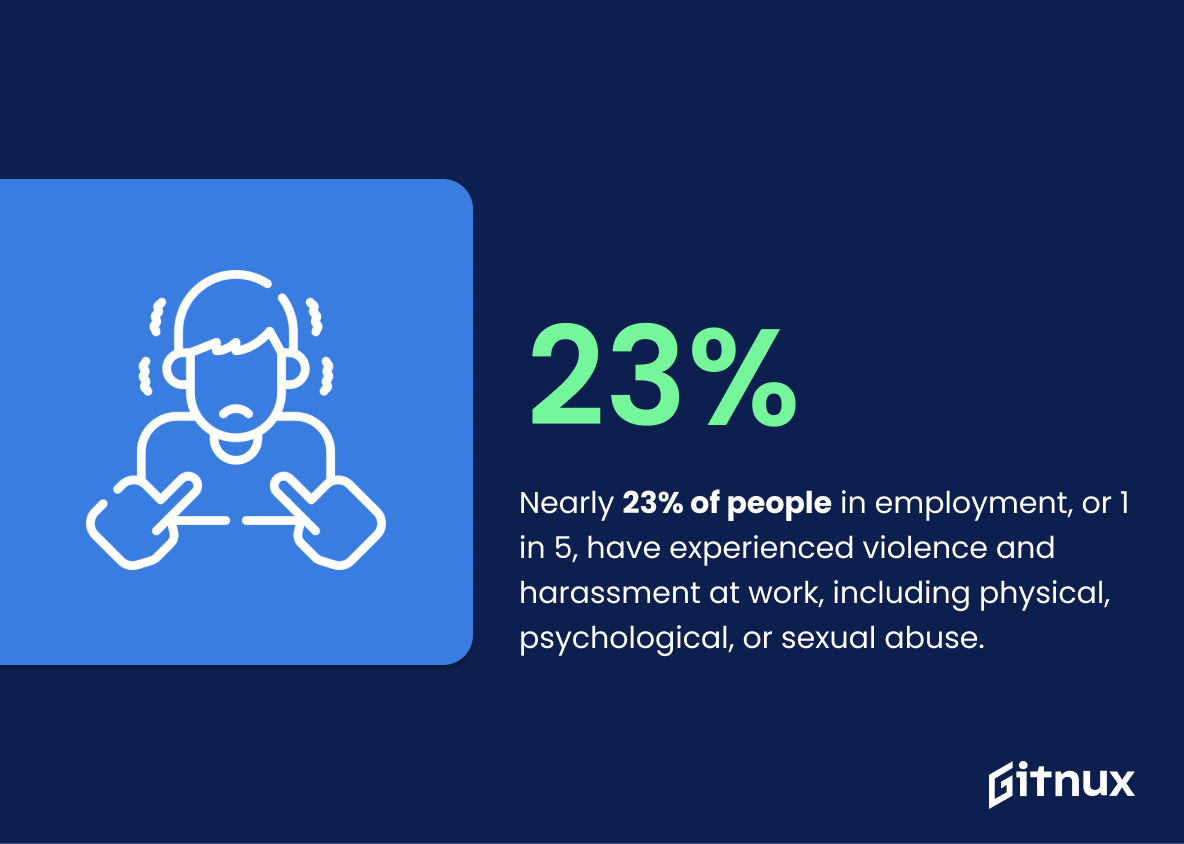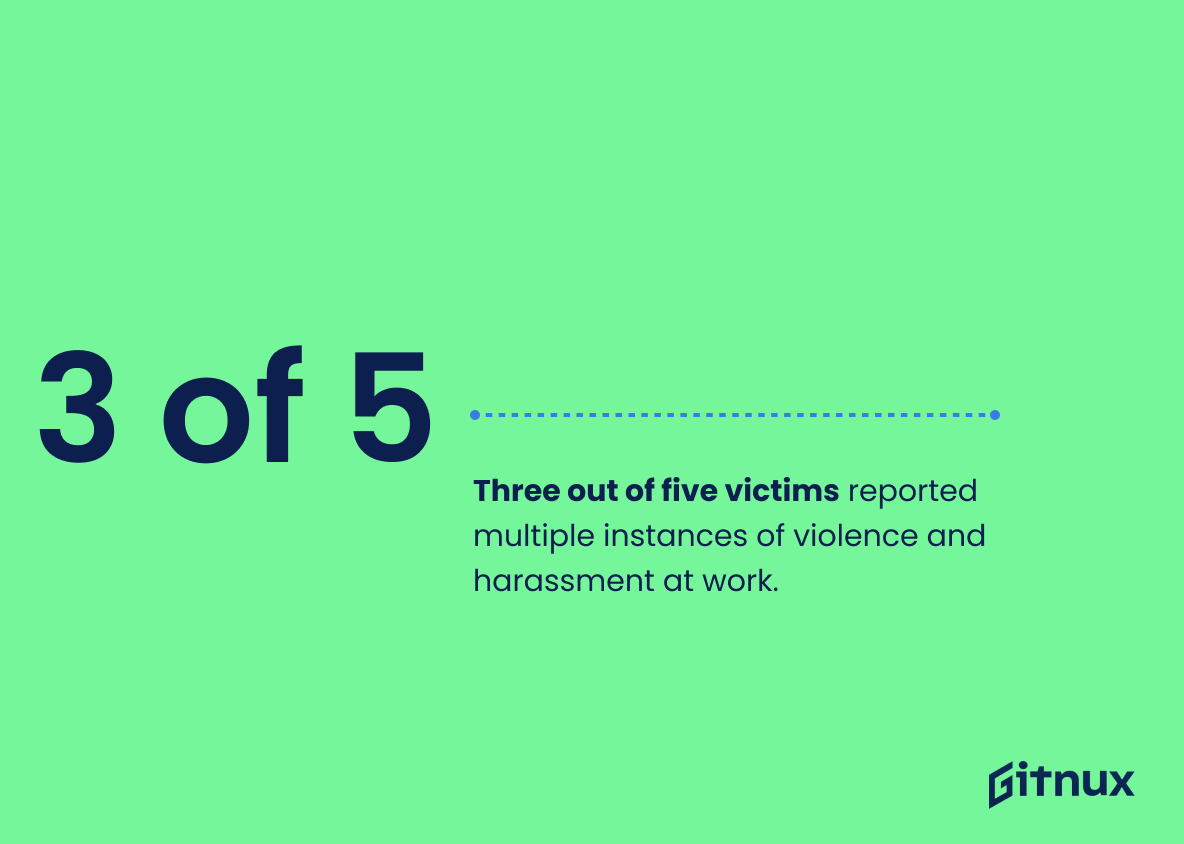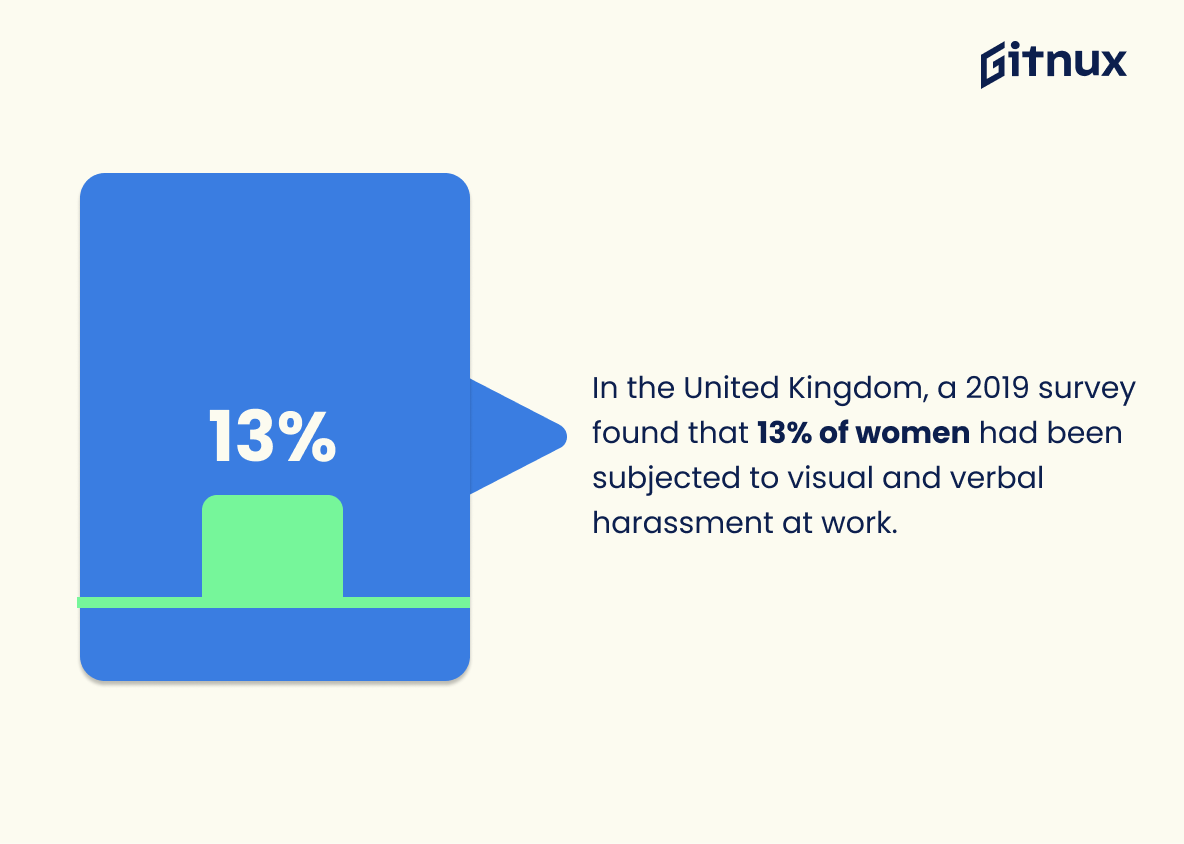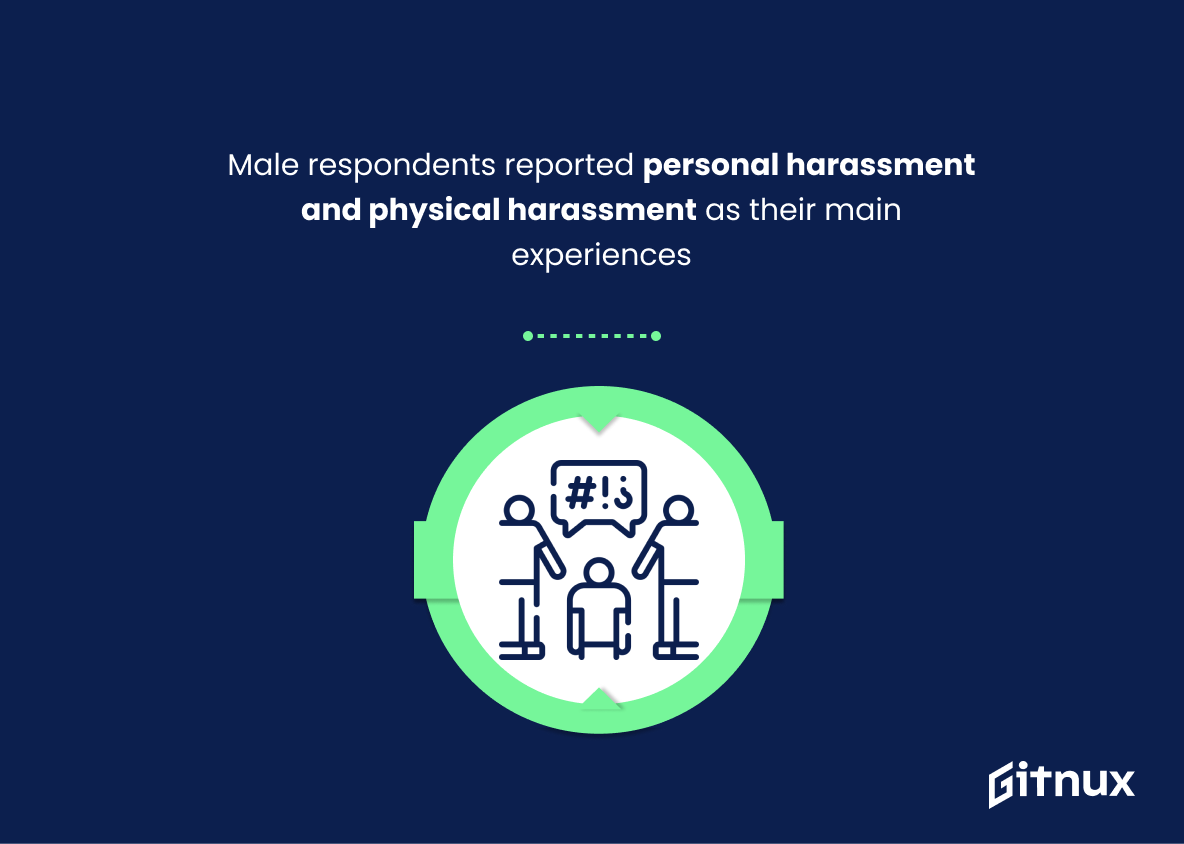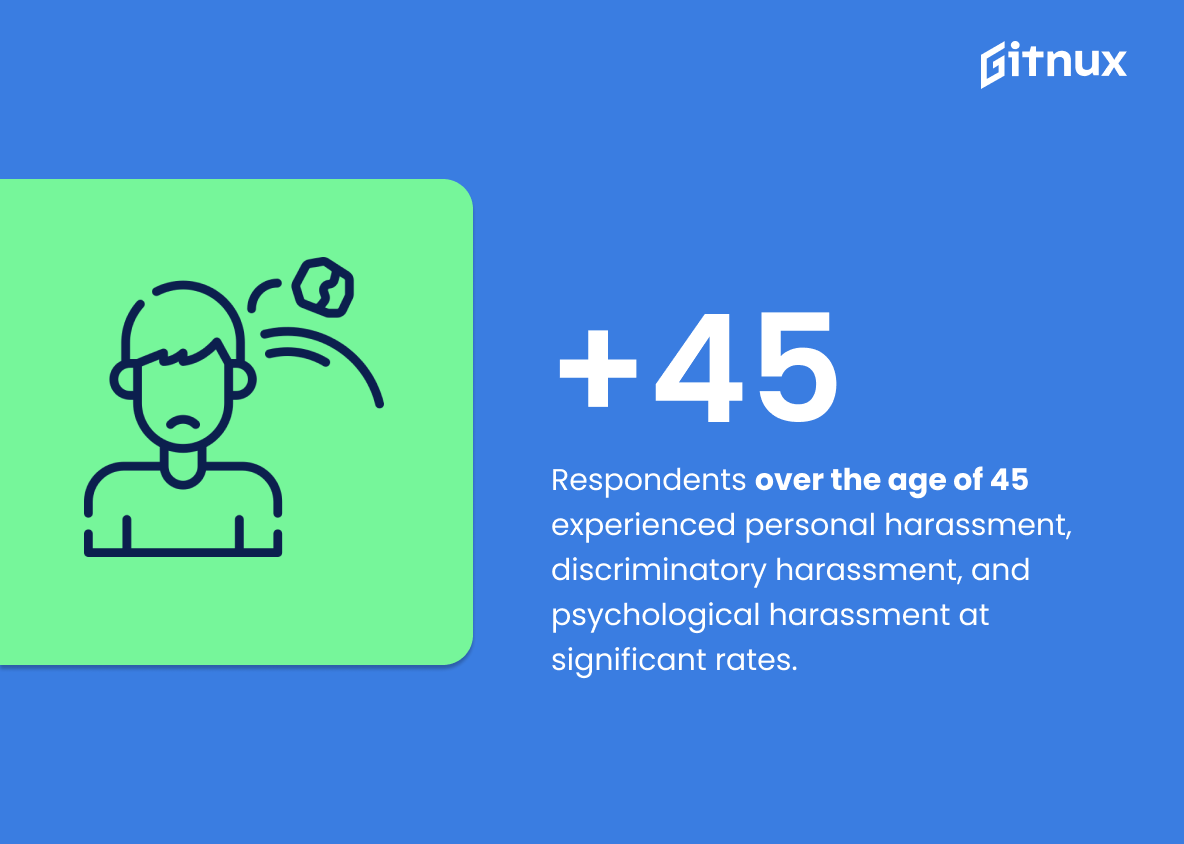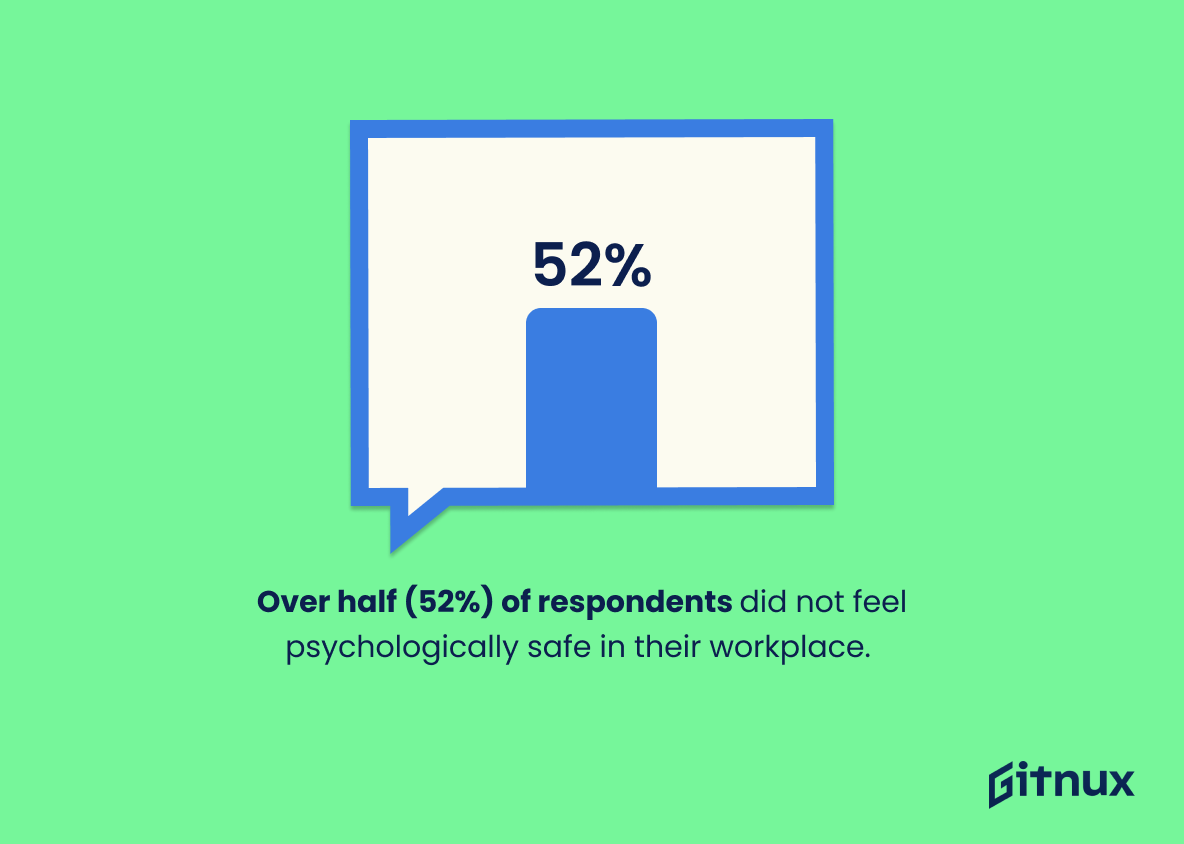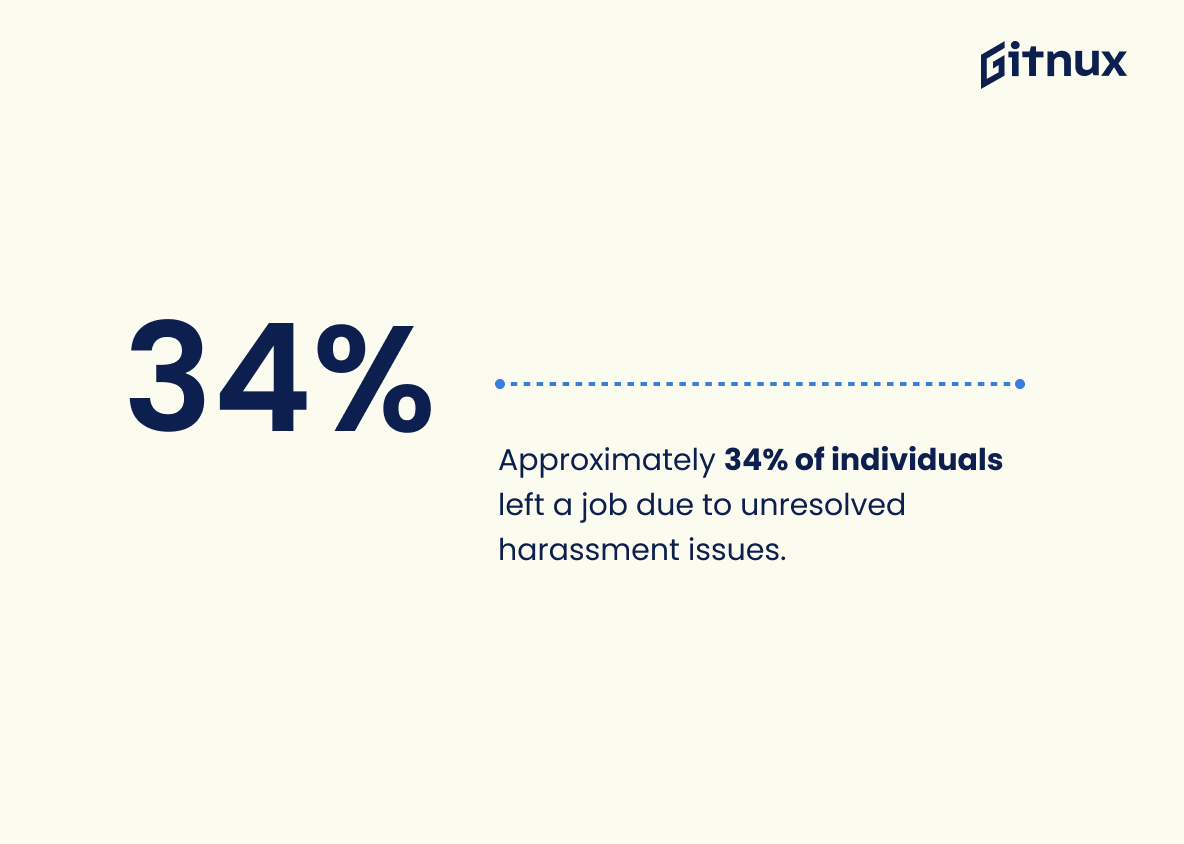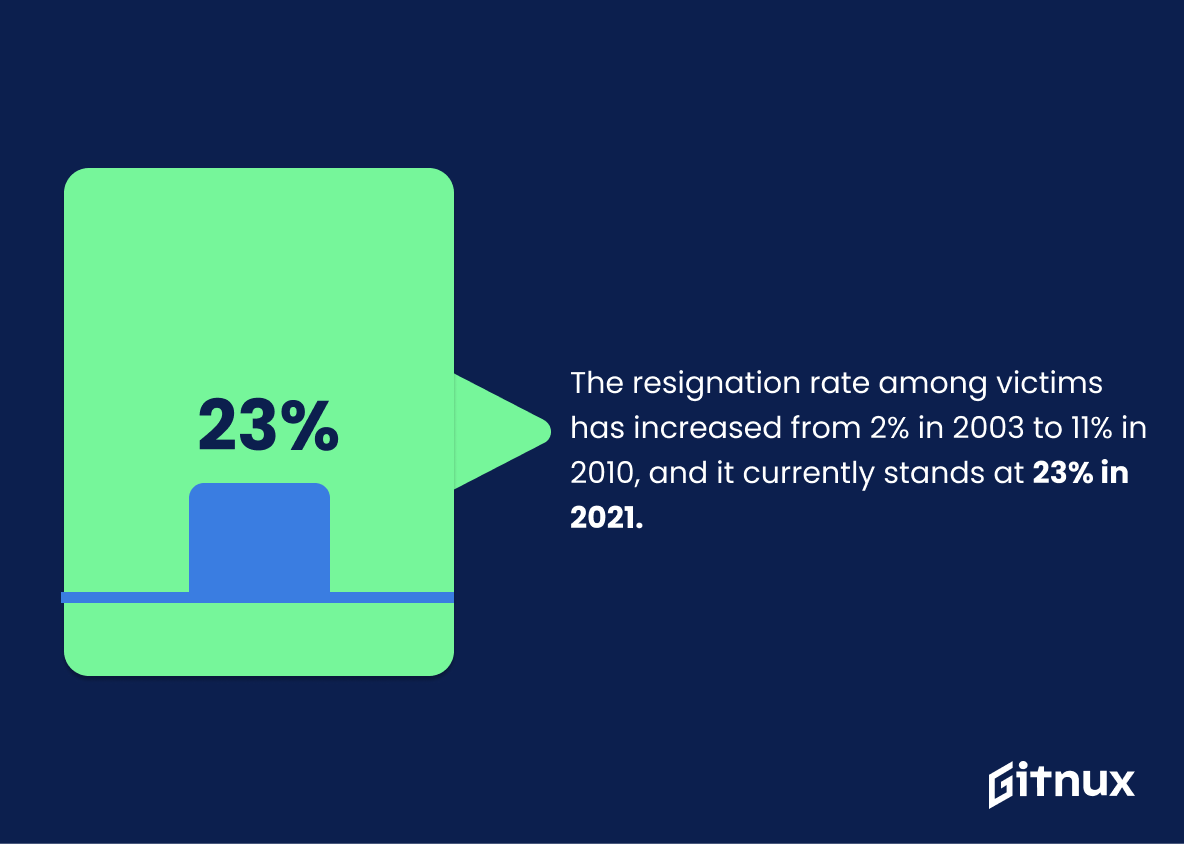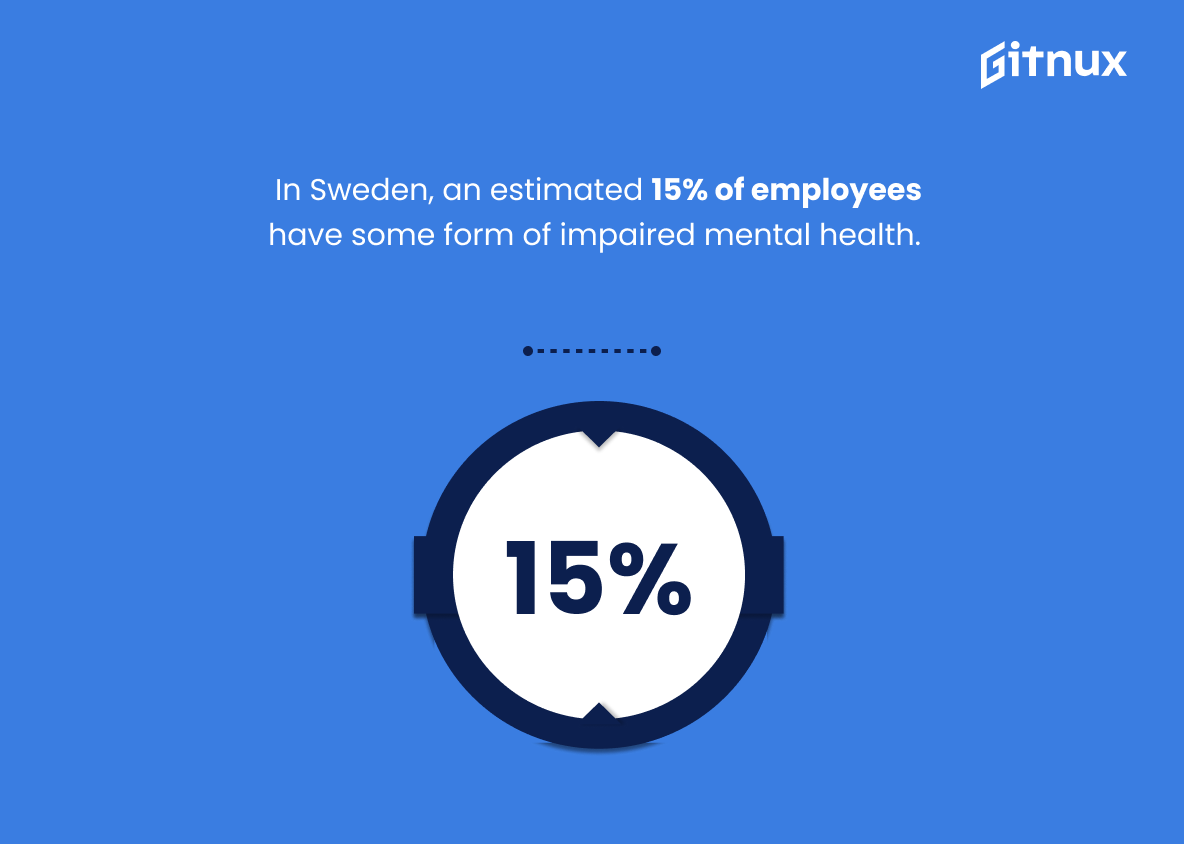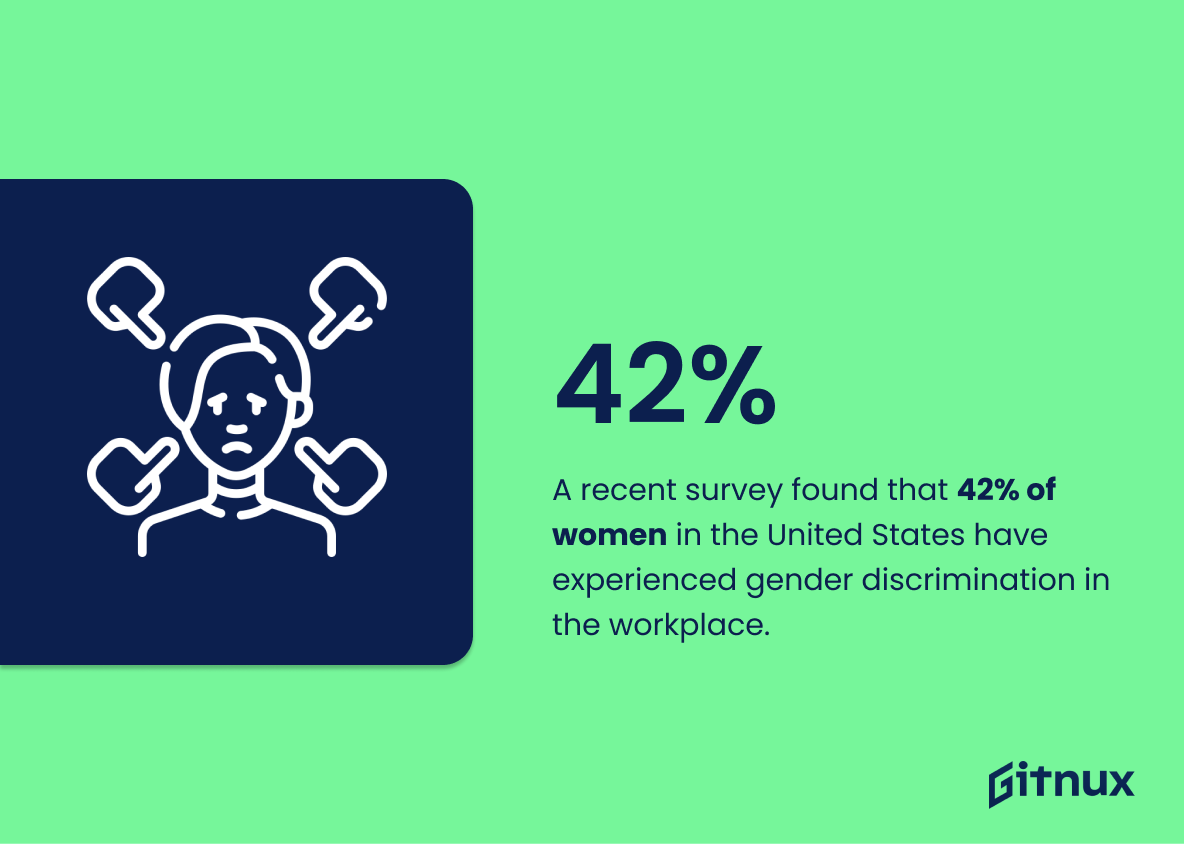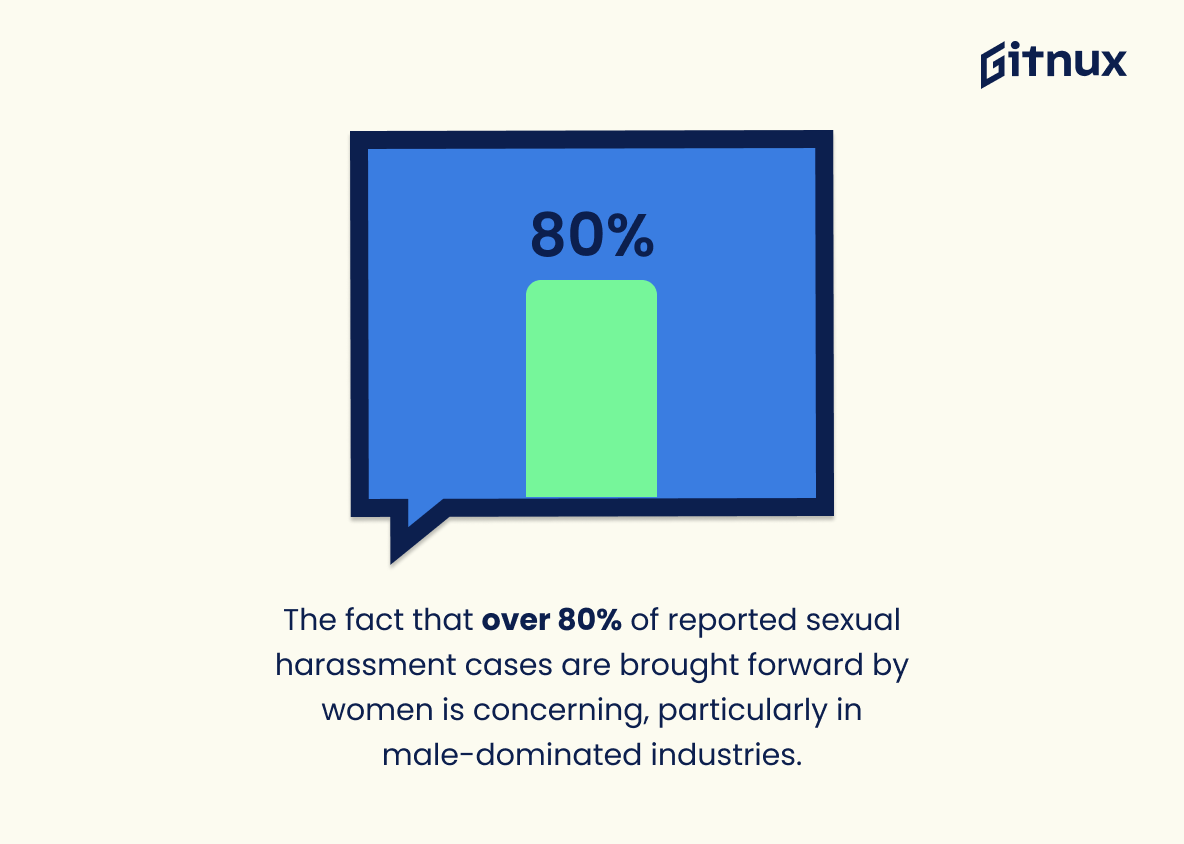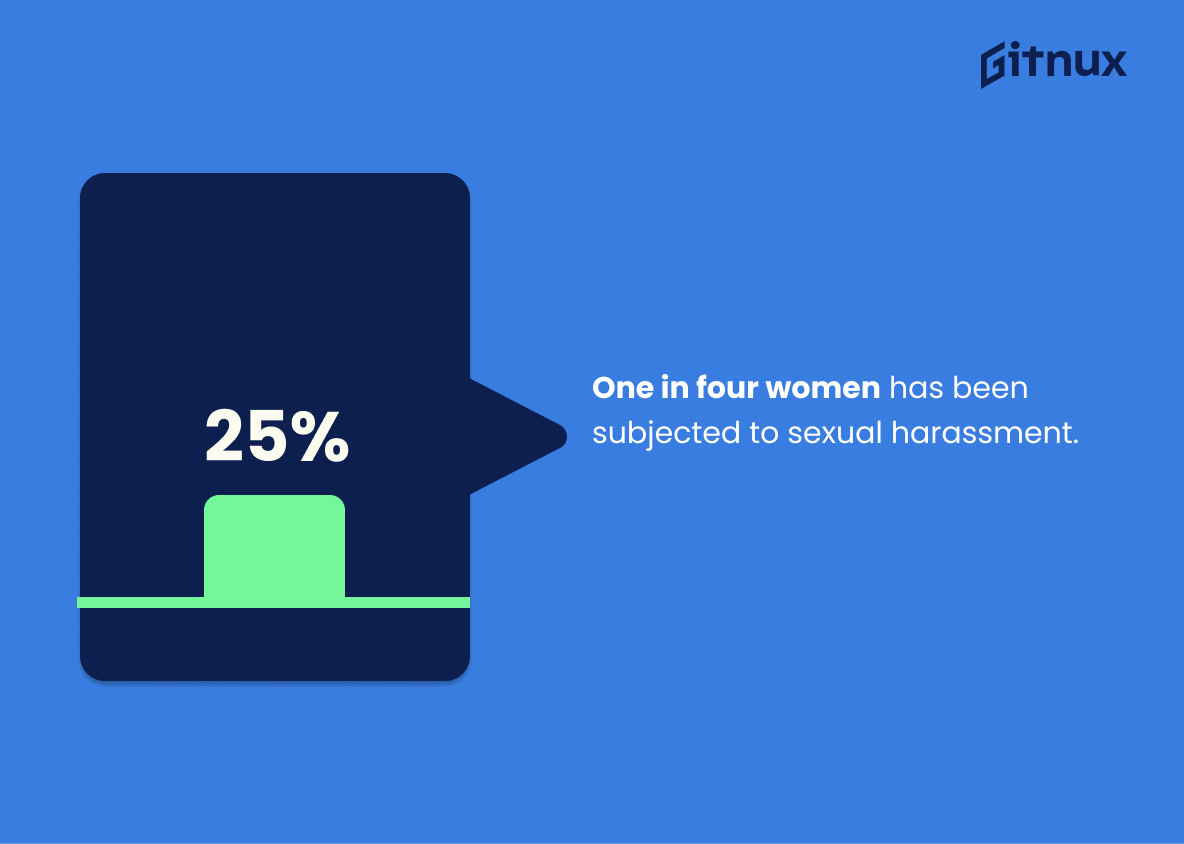Harassment in the workplace is a serious issue that affects many employees. It can cause physical, emotional, and financial harm, and can lead to decreased productivity and job satisfaction. Unfortunately, it is a widespread problem that often goes unreported.
In this blog post, we will discuss the statistics of workplace harassment, including its prevalence, the types of harassment, and the impact it can have on employees. We will also explore the steps that can be taken to prevent and address harassment in the workplace.
Harassment In The Workplace: The Most Important Statistics
- 44% of employees have experienced harassment at work.
- Only 1% of sexually harassed victims confront their perpetrators.
- 99% of employees successfully recognize a sexual harassment situation.
Harassment Types In The Workplace
Workplace harassment types can be of any form. Here are some of the most typical types of harassment in the workplace: discriminatory, personal, physical, power, psychological, online, retaliation, sexual, verbal or Quid Pro Quo sexual harassment. Below, we can check some of the most intriguing statistics.
1 in 5 people (almost 23%) in employment have experienced violence and harassment at work, whether physical, psychological or sexual, according to a new joint analysis.
A report found that only 50% of victims worldwide had disclosed their experiences to someone else, and often only after they had suffered more than one form of violence and harassment.
Globally, 17.9% of employed men and women said they had experienced psychological violence and harassment in their working life, and 8.5% had faced physical violence and harassment, with more men than women experiencing this.
6.3% reported facing sexual violence and harassment, with women being particularly exposed.
3 out of 5 victims said they had experienced violence and harassment at work multiple times.
38% still experienced harassment remotely, through email, video conferencing, chat apps, or by phone. Additionally, 24% believe harassment continues or gets worse through remote work channels.
According to a survey conducted in 2019, 13% of women in the United Kingdom have been exposed to visual and verbal harassment at work such as to whistling, rude gestures or comments.
As reported by a study, female respondents had experienced sexual harassment (38.8%) and discriminatory harassment/bias (36.4%).
Male respondents had experienced personal harassment/in-person bullying (55.8%) and physical harassment (51.1%).
Black respondents had experienced personal harassment/in-person bullying (38.9%) and racism (36.1%).
Asian respondents had experienced discriminatory harassment/bias (42.9%) and psychological harassment/misuse of power (42.9%).
Entry-level respondents experienced physical harassment and discriminatory harassment/bias (both at 55.8%).
Respondents over the age of 45 experienced personal harassment/in-person bullying (48%) and discriminatory harassment/bias and psychological harassment/misuse of power (both at 38%).
Workplace Harassment Effects On Mental Health Statistics
Without a doubt, harassment can be devastating for an individual in any part of their life, especially in the workplace where they spend up to half or more hours a day. Any kind of harassment can have damaging effects on a person’s mental health. Some shocking statistics are listed below.
A study stated that 17,9% of men and women, globally, have experienced psychological violence and harassment in the workplace, many mentioning that they have suffered from a mental illness and they feel depressed.
31% of sexual harassment or assault victims felt anxious or depressed afterward.
52% have not felt psychologically safe at work.
37% of harassed women claimed harassment negatively affected their career advancement.
34% have left a job because of unresolved harassment issues.
Women who reported experiencing both sexual assault and workplace sexual harassment had the highest risk of developing high blood pressure, with a 21% increase.
The victim resignation rate of 23% in 2021 has increased from 2% in 2003 to 11% in 2010 to its current level.
Women who reported experiencing workplace sexual harassment had a 15% higher risk. Those who reported experiencing sexual assault had an 11% higher risk.
In Sweden, according to a study, it has been estimated that 15% of employees have some form of impaired mental health.
About 5% reported severe anxiety and 3% had a depression diagnosis.
As for the prevalence of workplace bullying Rosander and Blomberg (2019) showed that 19% of employees were exposed to bullying behaviours to a degree that affected their health and well-being negatively—of those, 7% were exposed to ongoing bullying or severe bullying.
2.4% of 7603 Danish employees have reported being harassed in the workplace and 71% of employees were found to not report harassment in the workplace.
Harassment in the Workplace Statistics: Women
In accordance with numerous surveys and facts, women are the most frequent victims of harassment in the workplace. The stats are quite concerning.
According to a recent survey, 42% of women in the United States claim that they have faced some type of gender discrimination in the workplace.
In male-dominated industries, women are disproportionately more likely to be victims of some form of sexual harassment at work. In 2017, only 16.5% of sexual harassment charges filed with the Equal Employment Opportunity Commission (EEOC) came from men.
The fact that more than 80% of sexual harassment cases were reported by women is a huge cause for alarm and one of the reasons why work in male-dominated industries could be more challenging for women.
According to the Pew Research Center study, one-in-four working women say they have earned less than a man who was performing the same job.
Women account for 47% of the entire US labor force. However, they hold 6.4% of CEO positions at S&P 500 companies.
15% of female employees haven’t received enough support from their supervisors.
25% of women have been subject to sexual harassment.
Women are three times more likely to experience sexual harassment than men.
90% of black women in the tech industry experience sexism at work.
47.2% of female Muslim workers have experienced religious discrimination and Islamophobia at work.
Managers are twice as likely to hire a man.
60% of managers aren’t comfortable with working with or mentoring female co-workers.
51% of HR managers tend to be unintentionally gender-biased.
The gender pay gap around the world ranges from 3% to 51%. Globally, women earn 17.6% less than men.
23% of women are considered incompetent due to their gender.
Women of color make up 31.3% of the low-wage labor force.
Across various occupations, around 77% of women are verbally harassed, 51% are sexually harassed and 58% of women who are harassed in the workplace do not file for a complaint.
Harassment In The Workplace: Dealing and Prevention
99% of employees successfully recognize a sexual harassment situation.
34% of employees do not identify behavior that leads to a hostile working environment.
15% of companies have made an effort to create specific strategies to address sexual harassment issues.
141 countries have laws on sexual harassment in the workplace.
In a study, it was estimated that $2.62 billion is lost due to productivity loss as a result of sexual harassment in the workplace, costing the company an average of $1,053 per victim.
In 2018, the EEOC recorded 26,699 charges of sexual harassment in the workplace, with 7% of these claims being settled, recovering $134 million through an out-of-court settlement.
While most adults (74%) believe their companies take sexual harassment seriously, only 30% of women strongly agree that their employer properly handled harassment incidents.
50% have reported harassment. When they reported harassment, to whom did they report it? 55.3% say they reported it to their manager, 36.4% reported the issue to the HR department, and 8.3% reported it to an ombudsperson or a third party.
Only 53.5% of our respondents say their reported issue was fully resolved after they reported it. 24.2% reported that their issue was partially resolved. For 11.5%, their issue was not resolved, and no action was taken in regard to it. 4.6% report it not being resolved, but believe their workplace is working on it. 6.1% say that reporting made the issue worse.
In examining the data further, only 37.7% of female respondents saw their reported issue fully resolved, while 62.4% of male respondents saw their reported issue fully resolved, 66.9% of senior-level respondents saw their reported issue fully resolved, and 52.1% of entry-level respondents saw their reported issue fully resolved.
9.6% of female respondents said that raising the issue made it worse, and 8.5% of entry-level respondents said the same, whereas 6.1% of senior-level respondents and 4.2% of male respondents said that raising the issue made it worse.
85% are more inclined to report harassment if it’s truly anonymous.
72% believe their workplace wants them to report harassment.
Supplementary Statistics
75% of workplace harassment victims experienced retaliation when they spoke up.
Despite the prevalence of workplace harassment, many victims are still afraid to come forward due to the fear of retaliation. This statistic serves as a warning to those who are considering speaking up, and it emphasizes the need for employers to take proactive steps to ensure that victims of workplace harassment are protected from any form of retaliation.
1 in 3 women and 1 in 10 men have reported experiencing sexual harassment in the workplace.
It highlights the need for employers to take proactive steps to ensure that their workplaces are safe and free from harassment. It also serves as a reminder that sexual harassment is a serious issue that needs to be addressed, and that it affects both men and women.
45% of workplace sexual harassment reports are made by women, while 19% are made by men.
Women are disproportionately affected by this issue, and men are significantly less likely to come forward with their experiences. This is an important statistic to consider when discussing workplace harassment, as it provides insight into the prevalence of the problem and the need for further action to be taken to ensure that all employees feel safe and respected in their workplace.
60-70% of sexual harassment cases in the workplace go unreported.
Many victims of harassment are not coming forward to report their experiences, either out of fear of retribution or because they feel their complaints will not be taken seriously. This statistic serves as a call to action for employers to create a safe and supportive environment for their employees, and to ensure that any reports of harassment are taken seriously and investigated thoroughly.
90% of women have witnessed or experienced sexual harassment in the workplace.
This is an issue that affects a vast majority of women, and that it is an issue that needs to be addressed. It serves as a call to action for employers to take steps to ensure that their workplaces are safe and free from harassment.
61% of sexual harassment victims are female, 32% are male, and 4% are unspecified.
This is an important statistic to consider when discussing the prevalence of harassment in the workplace, as it emphasizes the need for greater protection and support for female employees.
The average sexual harassment lawsuit settlement cost to a company is about $250,000.
Thus, there is a high importance of taking proactive steps to prevent harassment and creating a safe and respectful work environment. The high cost of settling a sexual harassment lawsuit is a clear indication that companies must take this issue seriously and take the necessary steps to protect their employees.
81% of women and 43% of men have experienced some form of sexual harassment during their lifetime.
Sexual harassment is a pervasive issue that affects both men and women, and it is a problem that needs to be addressed. This statistic serves as a call to action for employers to take steps to ensure that their workplaces are safe and free from harassment.
Harassment complaints increased by 6.5% in 2018 in the United States.
The 6.5% increase in complaints shows that the problem is not going away, and that more needs to be done to address it.
61% of workers have experienced sexual harassment at least once in their workplace.
A majority of workers have been subjected to this type of mistreatment, and it is a widespread problem that needs to be addressed. This statistic serves as a call to action for employers to take steps to ensure that their workplaces are safe and free from harassment.
57% of employees believe their workplace does not take harassment seriously.
It is a clear indication that more needs to be done to ensure that employees feel safe and respected in their workplace. This statistic is a call to action for employers to take a stand against harassment and create a culture of respect and safety in the workplace.
67% of employees who reported harassment faced retaliation within their workplace.
Even when employees take the brave step of speaking up, they are often met with further mistreatment. This statistic serves as a warning to employers that they must take proactive steps to ensure that employees who report harassment are not subjected to any form of retaliation.
Approximately 30,000 sexual harassment complaints are filed annually in the United States.
This is an issue that affects thousands of people every year, and that it is an issue that needs to be addressed. It is a call to action for employers to take steps to ensure that their workplaces are safe and free from harassment.
On average, racial harassment complaints make up 45% of total claims in the workplace.
Despite the progress made in recent years, there is still a long way to go in terms of creating a safe and inclusive workplace for all. It is a call to action for employers to take a proactive approach to addressing racial harassment in the workplace and to ensure that all employees feel safe and respected.
21% of women have reported experiencing sexual harassment in the workplace, but many go unreported.
It highlights the need for employers to take proactive steps to ensure that their workplace is a safe and respectful environment for all employees, and to provide support for those who have experienced harassment. It also serves as a reminder that more needs to be done to raise awareness of the issue and to encourage victims to come forward and report any incidents.
53% of companies have increased anti-harassment training efforts since the start of the #MeToo movement.
Thus, companies are taking the issue seriously and are taking steps to ensure that their employees are protected from harassment. This is an important step in creating a safe and respectful workplace environment for all employees.
Conclusion
Harassment in the workplace is a serious issue that needs to be addressed. The statistics show that it is still a widespread problem, with many people feeling unsafe and uncomfortable in their working environment.
It is essential that employers take steps to create a safe and respectful work environment for all employees, and that employees feel empowered to speak out about any issues they experience. This will help to ensure that harassment is not tolerated and that everyone can feel safe and respected in their workplace.
References:
SwartzSwidler: “8 Types of Workplace Harassment (and How to Stop Them)”, cited in [Current Month] 2023 (Source)
ILO: “Violence and harassment at work has affected more than one in five people”, cited in [Current Month] 2023 (Source)
Statista: “In the past 12 months, have you been exposed to the following situations at work?”, cited in [Current Month] 2023 (Source)
AllVoices: “The State of Workplace Harassment”, cited in [Current Month] 2023 (Source)
InspiredeLearning: “16 Sexual Harassment in the Workplace Statistics You Need to Know”, cited in [Current Month] 2023 (Source)
OxfordAcademic: “Mental Health Problems as a Risk Factor for Workplace Bullying: The Protective Effect of a Well-Functioning Organization”, cited in [Current Month] 2023 (Source)
Source: “The Impact on Employees of Workplace Sexual Harassment”, cited in [Current Month] 2023 (Source)
Embroker: “Guide: How to Handle Gender Discrimination in the Workplace & 4 Ways to Prevent It”, cited in [Current Month] 2023 (Source)
WhattoBecome: “Mind-Blowing Gender Discrimination in the Workplace Statistics You Must Know”, cited in [Current Month] 2023 (Source)
WhattoBecome: “26 Shocking Sexual Harassment in the Workplace Statistics”, cited in [Current Month] 2023 (Source)
Chron: “Do Companies Try to Settle Harassment Claims Out of Court?”, cited in [Current Month] 2023 (Source)
Everfi: “How Does Sexual Harassment Affect the Workplace?”, cited in [Current Month] 2023 (Source)
